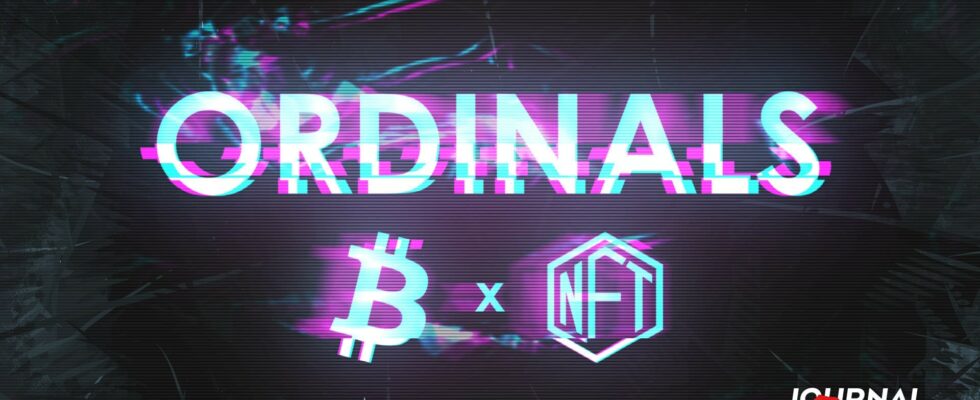Earlier this year, the Bitcoin network saw a massive surge in interest following the emergence of the Ordinals protocol. Subsequently, the network was marked by a new evolution with the appearance of the BRC-20. Let’s come back together to this phenomenon which will have marked 2023.
Introduction to Ordinals and Registrations on Bitcoin
At the start of 2023, a new phenomenon emerged on the Bitcoin blockchain. Titled Ordinalsthis protocol arrived with a proposal that was surprising to say the least: democratize NFTs on Bitcoin.

However, these NFTs have nothing to do with the usual NFTs on blockchains like Ethereum. Indeed, unlike traditional NFTs, which are based on standards such as ERC-721 and ERC-1155 and which are generally stored on smart contracts, Ordinals write NFTs directly on satoshis. As a reminder, the satoshi is the smallest accounting unit of Bitcoin.
To do this, Ordinals uses a process called Registrations, which aims to associate data with a satoshi. Each inscription is unique and inseparable from a specific satoshi. This provides complete immutability, unlike NFTs which can be modified with new data or characteristics.
The year 2023 marked impressive growth for the Ordinals protocol. This is despite a bear market in the cryptocurrency sector. Within the first 200 days of launch, more than 1.14 million Listings have been created by Bitcoin users. Currently, the Bitcoin network has nearly 50 million Registrations.


This massive enthusiasm around Ordinals has led to a significant increase in activity on Bitcoin. Not surprisingly, this increase in activity has caused significant congestion on the network. As a result, the network recorded a significant increase in transaction fees.
Creation and Development of the BRC-20 Standard
While Ordinals reigned supreme over Bitcoin, a new type of asset emerged: BRC-20.
In practice, the BRC-20 standard, inspired by the Ethereum ERC-20 standard, allows the creation of tokens on Bitcoin. The fundamental difference between the two standards lies in the use of smart contracts: unlike ERC-20 tokens which depend on these contracts for their functionality, tokens BRC-20 uses Inscriptions democratized by Ordinals to store a script on the Bitcoin network. This allows users to create tokens by linking them to satoshis, similar to Ordinals.
These differences highlight that BRC-20 tokens are a simpler and more constrained implementation compared to ERC-20 tokens, due to the limited programmability of the Bitcoin network.
The process of creating and deploying BRC-20 tokens on Bitcoin involves several steps. First, developers must design the structure of the token, defining properties such as name, supply total, and maximum quantity to mint, often encapsulated in a JSON object. Then, this data is entered into the Bitcoin network via the Ordinals protocol, creating the BRC-20 token. Once registered, new tokens can be minted by users, within the limit of the predefined maximum quantity.
The popularity of the BRC-20 standard has grown significantly since its introduction. As of May 2023, over 15,000 different tokens have been minted using the BRC-20 standard.
ORDI exceeds one billion dollars in capitalization
At the same time, the market capitalization of these tokens had reached one billion dollars.
Finally, on December 7, the iconic BRC-20 ORDI was the first Bitcoin token to exceed $1 billion in capitalization.


While BRC-20s were initially restricted to the creation of tokens on Bitcoin, they quickly found other areas of application.
For example, in May 2023, Fiat gateway provider Stably has launched a stablecoin based on the new Bitcoin standardallowing BTC holders to store an equivalent of the dollar on Bitcoin and use it for payments.
Controversies surrounding Ordinal and BRC-20 tokens
The adoption of BRC-20 tokens on the Bitcoin network was not without controversy. Thus, many Bitcoin defenders have pointed the finger at Ordinals and other BRC-20s. The latter accuse them of causing congestion on the network.
Others, such as developer Luke DashJr go even further. Indeed, the Bitcoin developer recently stated that Ordinals exploit a vulnerability in Bitcoin’s code to exist.
“‘Signups’ exploit a vulnerability in Bitcoin Core to spam the blockchain. Since 2013, Bitcoin Core has allowed users to set a limit on the size of additional data in transactions they relay or mine (`-datacarriersize`). By obfuscating their data as program code, Inscriptions circumvent this limitation. »
So, the developer decided to go on a crusade against these new applications on Bitcoin. To do this, he simply modified the code of Bitcoin Knot, the Bitcoin client he created, so that it no longer accepts transactions that include Registrations.
In addition, its mining pool Ocean Mining also censors transactions that have Registrations.
Fortunately for holders of Ordinals and BRC-20, Bitcoin Knot and Ocean Mining are far from being market leaders. Thus, the majority client of the network, Bitcoin Core, has not for its part implemented no restrictions in its latest update. For their part, the developers don’t seem to see the Ordinals in the same light as Luke DashJr.
Ordinals outside of Bitcoin
While the phenomenon of Ordinals has long been restricted to Bitcoin, the Inscriptions process was subsequently ported to other blockchains.
In turn, several EVM blockchains have been taken over by Inscriptions. So, Avalanche, Polygon and Fantom recorded record activity following the emergence of Registrations on their blockchains.
However, this does not always turn out for the best. Thus, the Arbitrum network sequencer was unable to handle the massive influx of transactions emanating from Registrations made on the L2. So much so that he found himself offline for more than an hour.
Whatever we think, Registrations have revived activity on many networks. In addition, they have enabled the emergence of new solutions, still in their infancy, such as Rollups on Bitcoin imagined by ChainWay.
